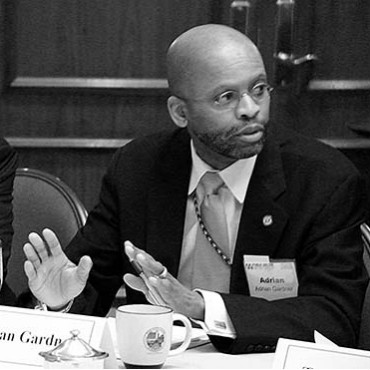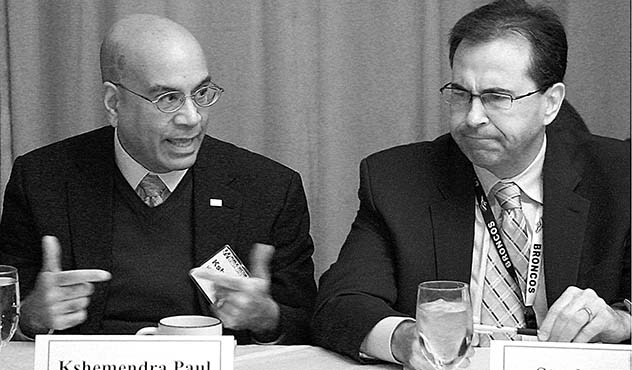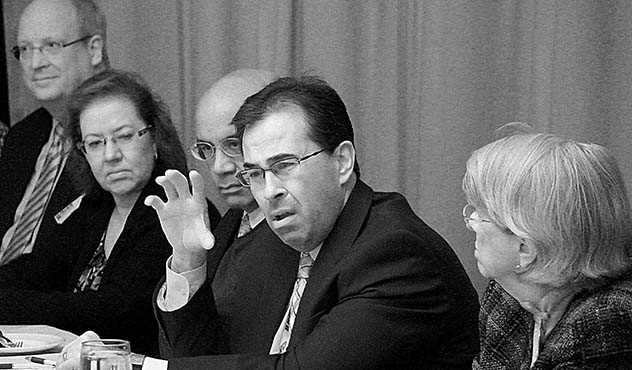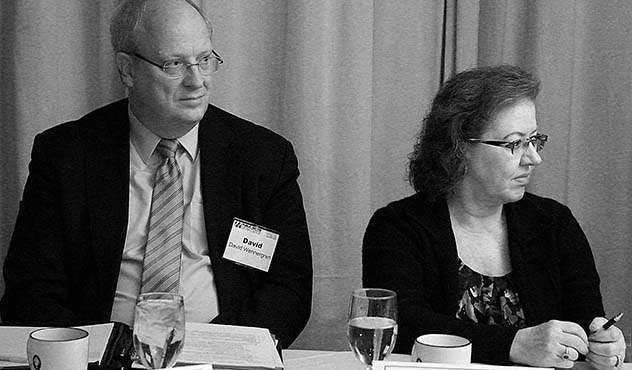What CIOs really think about FITARA implementation

In a candid and wide-ranging discussion, the leaders tasked with making IT reform a reality debate the key (and sometimes still missing) ingredients.

FEMA CIO Adrian Gardner at an FCW-hosted roundtable on FITARA. Photo credit: Aleida Fernandez.
The Federal IT Acquisition Reform Act required all agencies covered by the law to have implementation plans in place by Dec. 31, 2015. So in early December, FCW gathered a broad cross-section of current and former agency executives for a two-hour roundtable discussion on their FITARA implementation efforts — and came away with the following insights on the realities of reforming federal IT.
The discussion was on the record but not for individual attribution. (You'll find a list of the participants at the end of this article.)
Ready to roll...
Perhaps most striking was the group's enthusiasm for making FITARA's reforms a reality and their optimism that getting the changes to stick might actually be possible.
Plenty of serious obstacles must still be overcome, and participants discussed them at some length. But "we're sort of past having a theoretical discussion," one CIO said. "We're moving into actually operationalizing FITARA."
On the day of the roundtable discussion, the Transportation Department took a clear step in that direction in the form of a memo — signed by the agency's CIO, chief financial officer and chief acquisition officer — that freezes new IT spending for 90 to 120 days so that a baseline assessment can be completed.
Other executives agreed that getting clearer pictures of their agencies' IT investments was critical, though they were seeking that visibility in different ways.
"At [my agency]," one CIO said, "we started implementing FITARA basically three years ago before FITARA even existed. We started...to talk about review of the entire agency."
It's possible to get a "single operation image for the entire organization," the CIO added. "If you have the right leadership, and that leadership is focused on...accomplishing this thing, you can do great things in 120 days. You can find out 80 or 90 percent of the IT — of the spend, personnel, process and technology."
Another agency CIO concurred. "FITARA works great in theory. [In practice, though,] we need to make sure that the culture changes, along with some of the requirements that have changed.... It takes the entire organization, and it is a cultural shift because people are going to have to report and provide documentation and provide roadmaps where they did not have to do that before. It's constant communication."
"FITARA gives us the opportunity to fill a need," another participant said. "The challenge is: Do we have the intestinal fortitude?"
The executive noted that the 1996 Clinger‑Cohen Act also called for significant changes, but implementation efforts never really stuck. "We don't want FITARA to end up the same way that Clinger‑Cohen did." That was a refrain throughout the discussion.
One CIO recounted a clear example of Clinger-Cohen reforms being aggressively rebuffed: The Energy Department's CIO at the time "decided she was going to put Clinger‑Cohen in a draft memo and circulate it for the customer base to review. For the first time in the history of DOE, all the lab directors from all the national labs got together, drafted a memo within 24 hours [and] sent it to the secretary. [The CIO] was actually moved to the side in 48 hours."
Multiple participants said that for FITARA to avoid a similar fate, agencies must do a much better job of cataloguing and categorizing IT. As one CIO put it, "It gets to the question we were talking about: What do you call IT, and how do you bucketize it, and how do you measure it?"
Two participants said efforts are underway to provide better benchmarks by adapting work the private sector has done to drill into its data.
"When we look back on how successful FITARA is, there is going to be a fairly interesting story around the level of commitment that we place on IT portfolio management," a non-CIO agency executive said. "Knowledge is power."
With truly robust portfolio management, the agency executive added, "the conversation changes. FITARA becomes really valuable. There's real financial savings, [and] these projects get out quicker and [are] more successful, based somewhat on the level of commitment that we have to portfolio management."
Another non-CIO participant noted that agencies' organizational charts could also prove critical. "In our case," that executive said, "we have our CIO and our senior procurement executive reporting to the same person. This helps the relationship tremendously. You really don't have an option but to cooperate."
A large-agency CIO agreed but noted that not all government organizations were so lucky. "If you look at FITARA, there's a horizontal and longitudinal problem," the CIO said. At the department level, "I've got to work with three other CXOs so that we're all marching as one." Different component agencies, however, have "all sorts of autonomies," and those bureau CIOs don't have full control at their level either. "They have to work horizontally across their CXOs and work with programs that often direct appropriations. Look at their problem!"
Another large-agency CIO agreed. "We have CIOs report all over the place. There's not one model. Agencies treat IT very differently. It's moving in a more consistent direction, but it's not yet consistent."
And while getting buy-in from elsewhere in the organization is crucial (see next section), the CIOs acknowledged that the new mindset begins with them.
"One of the things I like to say in these meetings we have with undersecretaries and others is that the IT is never more important than the program, but the programs can't operate without the IT," one CIO said. "Historically, we haven't thought about the IT as [being as] important as the program policy. We sit in the back of the room sometimes when these meetings happen. I don't think we can do what [FITARA calls for] until we're always sitting at the front."
And to be taken seriously, CIO offices must do a better job on the basics, another CIO said.
"It's hard for me to go in and complain about a $5 million procurement [done without CIO input] if my email is not up," that CIO said. "If they are having a bad experience with the services you're presently providing...it is very hard to go and put a stop-work [order] on a contract that might have a mission impact."
Yet for all the obstacles, FITARA "is starting to get momentum," one executive said. "I've been doing this for quite a while.... I'm excited about the fact that there seems to be some real commitment [to] getting down and going out and figuring the stuff out."
...but battling for buy-in...
The biggest challenge, participants agreed, is still on the people front: getting buy-in from agency heads, acquisition shops and mission owners at their agencies.
"Traditionally, money doesn't go in one place to be spent on IT," one executive said. And "people aren't expecting it all to be spent by the CIO.... People don't even know how to work in that manner. You can't switch because no one's ever done [it] like that."
The participants noted that the changes don't just involve CIOs and acquisition officers, but also Office of Management and Budget examiners and even congressional appropriators.
"We're going to need to have a very direct conversation about what is IT," one CIO said. "That's a huge part of the problem right now and one that is missing.... Everybody can say, 'Go to A‑130,' but we need to have a real hard discussion about that."
Several participants said one way to force those discussions is to take an expansive view of FITARA's CIO authority and insist that the CIO review everything remotely IT-related.
Interagency agreements pose a particular challenge, several participants said. "We know agencies go to [the General Services Administration] or other organizations because they don't want to follow the rules," one said. "We see that happen."
Others, however, argued that interagency agreements could be reviewed without much trouble. "Nothing should be purchased in your component [or] in your department if it's not under an existing system voucher," one CIO said. "If you start finding shadow boundaries [or] if they're not within your contained boundary, you've got to say, 'Why the hell are we buying this?'" And CIO signature requirements could be added.
"It's not perfect, but it by and large works," the CIO said. "My concern is it's based on the relationship. I have a great relationship with my chief financial officer and my chief acquisition officer. But if they change, [whistles] that's a lot of work to build that back up."

Establishing those relationships is the central task for most agencies' FITARA implementation efforts, the participants said. And there's no substitute for time-intensive, face-to-face interactions.
"We went around individually to the staff offices, the CFO, the CAO...and talked with them, explained what the strategy was, shared with them what we believed their role was going to be," one agency executive said. "There was a lot of clarification going on, and it led to a better partnership because now we knew who had responsibility for what role in FITARA."
"Face‑to‑face meetings are key," another participant said. They create "a lot more trust and integrity. The change was scary."
"The discussion wasn't about, 'This is my authority now,'" the executive added. "The CIO said, 'I have some objectives for implementing FITARA here. I want to drive down our costs. I want to make sure we go into contracts that don't create vendor lock‑in.' They were objectives that certainly no one could disagree with. No one could say, 'I really want to be spending more than I need to.'"
A former federal CIO who now works in the private sector said government CIOs have the challenge of working across the entire organization. "It lives or dies on a few key relationships because your challenge as a CIO is to get everybody to move in the right direction, and unless mom or dad cares as well, then you have a problem."
And agency heads — the proverbial "mom or dad" — must be convinced that they should care. "They're hearing all of this," a current agency executive said. "They're hearing FITARA, they're hearing cyber sprint, they hear digital services, they're hearing agile. Putting that in context for them is really important right now. They're confused."
And even agency-head and CXO support are not sufficient, another former CIO reminded the group. "It's really important that we recognize you're not going to do agency transformation out of the CIO shop or even the CIO and CAOs together. There needs to be mission-side governance."
Several agency participants said getting that buy-in depends on understanding the incentives. "Everyone wants to be part of a win‑win situation," one CIO said. "Make sure they understand that 'I need you to be the executive sponsor, I need you to lead.... The outcome for you is going to be this mission success. Then if it doesn't work, blame me.'"
The participants agreed that the career employees farther down on the organizational chart are also important, as opposed to focusing only on shorter-term political appointees.
The challenge at that level is often not buy-in so much as basic awareness, one executive said. "For some reason, it's really hard to communicate all the way down to bottom-level folks," the executive said. "We know we've got our senior IT leadership and our project managers. We know they know about it.... But I don't know how we get the feedback to know that everyone who needs to know the message has it and understands it."
At one agency, that staff-level communication has taken the form of meetings with every stakeholder involved in program portfolio reviews. More important, an executive from that agency said, those stakeholders were tasked with setting the roadmap for that process.
The first group was then asked to tell the others what to expect. "We told them we're not going to tell other groups about the program portfolio reviews," the executive said. "'You tell them how we interacted with you and what your experience was, and then you come back and tell us what we can do to improve.'"
That sharing of control, the executive said, "bought us miles and miles of goodwill."
Another executive said her agency was conducting biweekly "study sessions" with acquisition employees. "I thought this wouldn't work, but we are getting 65 to 70 people every two weeks wanting to learn.... We are turning people away because we don't have the capacity."
"The more that the CIO community can work with procurement," the executive added, the better the odds will be for real reform. "Bring people in. Let them sit in on meetings. Let them listen to this. Let them be part of the win."
...and scrounging for resources...
Participants said people are essential to FITARA implementation in another sense as well: CIO shops need the resources to properly execute the law's requirements. And although money helps, qualified employees are really the key.
"FITARA doesn't give you more people," one CIO said. "You have to figure out that balance of the acquisition cycle in FITARA and the meeting of the mission without impeding the delivery of that mission. That's a weighty problem for the rest of the team."
"My overhead is increasing," another said. "My office is now a full acquisition review organization. Probably 35 percent of my business right now is that overhead."
Another CIO agreed. "This is additional work on top of what we have today. We do these things, but we have not hired anybody to do compliance reviews or to take a look at [whether component agencies are] actually following the policies that we write. And you need to do that if it's going to work because if you don't enforce it, people will return to the way that they know how to work."

Most participants said their agencies are reallocating existing staff or, more often, loading additional responsibilities onto already stretched team members. But the CIOs at the table agreed that dedicated employees are needed, with headcount estimates ranging from one-person teams to as many as 15 people for a larger department.
No one expected adequate staffing anytime soon, however. "We're going to have to get creative," one CIO said. "There won't be as many people as we want this year."
For larger agencies, a FITARA headcount of eight seemed to be a realistic, if ambitious, goal. But "I don't know how we're going to do that," another CIO said. "Today, there's nobody whose job it is to do this, or it's everybody's job. We need more resources under FITARA to look at all those acquisition opportunities and look for efficiencies."
Others held out hope for help from the Office of Management and Budget. "In our pass-back, this year and last year, we got money for digital services," one participant said. "That's great. We would love to have resources for digital services. But there is more value in having some resources apply to FITARA and ensuring that we're doing the things we say we're going to do.... My hope for OMB and others is [that] they look at this and reconsider as well. Is there flexibility in how we get some of those resources?"
A CIO who represented a large federated agency said his team might look to the components for help. "Can we cajole the agencies into funding a small portion of that contract [to cover FITARA implementation] and have some sort of reimbursable agreement?"
A non-CIO at the table urged her colleagues to turn to acquisition teams for help. "Don't throw your requirement with your contracting office," she said. "Invite the contracting office to come sit with your team. [They] really want to help you."
Several participants said more budget expertise is needed in CIO shops. "A very, very important part of what's going to separate success from failure here is having that skill and that expertise in the organization," one executive said. "To be successful, IT shops are going to have to have budget people who are as good as the agency budget people are — and better in the sense that they know IT backwards and forwards."
That reality check is sorely needed, a government participant agreed, because "we have good budget models, which are not to be confused with how IT really works."
CIOs voiced frustration at having so many needs with no way to fund them. "FITARA is an unfunded mandate," one said. "And if I want to move some people around, I've got to look forward to nine months of paperwork to get these people over into the other side."
Still, an industry participant said, "we can't let the fact that you're not going to get all the resources in the CIO shop stop us from trying to do this. Having been in these roles, it looks like an excuse, and it doesn't go over very well."
One government IT executive agreed, adding that her agency had relied heavily on borrowed employees to craft the implementation plan. "We went to [the components] and said, 'Here's what we need to do. We will take whomever and whatever you could give us to get to the end zone in both August and November.'"
"It wasn't ideal," she added. "We wanted dedicated resources, but we worked around it. And it gave them skin in the game. They were there every week, working with our team.... By building the sausage, they could see what it took in order to get to success."
"It is that partnership model and co‑opting resources" that will be the key, a former CIO said. "I know it's not easy, but that is the model that you have to start to drive for in order to get the resources."
...all with an eye on the clock
Resources or no, most of the participants said 2016 would be critical — partly because of OMB's deadlines but mainly because they wanted to make progress before a new administration arrives in January 2017.
"We have to do FITARA this year like our house is on fire," one CIO said. "Next year, when you're in a transition, IT is not the first thing to think about. It's going to take some time for people to understand."
Another CIO, however, cautioned against overpromising. "FITARA is a three- to five‑year runway, but no one wants to hear that," he said. "A lot of us want to do the right thing. We're looking for it, but we know that we're not in for a sprint. We're in for a marathon."

There was some agreement on that point, with several participants saying many in government don't believe rapid transformation is possible. "There's been too much of, 'Keep the old systems going because the investment to do a new system is so massive,'" one executive said. "'Let's not even do it until this thing is completely not workable.'"
Others around the table said CIOs had too often been the brake, and the community risked squandering FITARA's potential if IT leaders don't move quickly.
One current CIO was particularly strident on the subject. "When we go to folks in leadership positions who are delivering mission, they say, 'I can't wait five or 10 years to get that capability,'" the CIO said. "And what do they do then? They go on the side, and they create the capability. They say, 'My CIO didn't meet my needs.'"
"Either I take the leap or I don't," he added. "We keep putting Band-Aids on it, keep it running. We never rail against where we really need to go. We've got to begin to change this conversation as far as what our role is and meet strategic goals of our individual entities and organizations."
Making FITARA's reforms stick, one industry participant said, must "be a key transition issue. The next set of agency heads have to come in with part of their president's management agenda being, 'We're going to care about FITARA, we're going to have the CIOs back, we're going to work across agencies.'"
Another participant, however, pointed out that support under the next administration might not be guaranteed. "Regardless of which party it is...it's so easy to throw the baby out with the bath water," he said. The challenge for CIOs between now and Election Day is to clearly make the case for the next administration that "there are things that matter that you need to continue, even if you want to rebrand or change the name. These are the issues that you'll need to take on right away."
One CIO added that, too often, "we don't do a good job storytelling as to what and why. What is the outcome that we desire? All our metrics are all very tactical or output-based."
Others were less worried about future support and pointed to Congress' continued focus on FITARA. Rep. Gerry Connolly (D-Va.) has made it clear he will ensure the law he co-authored is implemented, one participant said, and "it's a bipartisan effort."
"In the short term," another participant said, "it's going to provide the spotlight we need to manage the administration. It doesn't matter who comes into the White House next. This is still going to be important."
"Having said that," he added, "the sense of urgency is welcomed and necessary. The folks in this community laying solid foundation post-2016 is critical."
And another participant, who was actively involved in the 2008 presidential transition, said that if the community works together in 2016, it can go a long way toward insulating federal IT from any politics that might arise.
"When the politicals came in," he recalled, "there was a sense of camaraderie across the CIO career-employee community. There's an opportunity now to build that same esprit de corps [and present the incoming administration with a clear message:] Here's how things really ought to operate.... You can focus on your priorities that you came to do and not worry about IT infrastructure and cyber incidents nearly as much. We've got the ball."
Discussion participants
Jonathan Alboum, CIO, Agriculture Department
Laura Auletta, Executive Director of Policy and Acquisition Workforce, Department of Homeland Security
Richard Beutel, Principal, Cyrrus Analytics and Former Senior Adviser and Counsel for Acquisition Policy
House Oversight and Government Reform Committee
Sonny Bhagowalia, CIO, Treasury Department
Dan Chenok, Executive Director, IBM Center for the Business of Government and Former Chair, Industry Advisory Council
Fawn Freeman, Director, Mission Investment Solutions Division, Environmental Protection Agency
Adrian Gardner, CIO, Federal Emergency Management Agency
Joyce Hunter, Deputy CIO, Agriculture Department
Steve Krauss, Director of Category Management Strategic Execution, General Services Administration
Elena Larsen, Associate Director, Mission Investment Solutions Division, Environmental Protection Agency
Bill Lochten, National Vice President, Software AG Government Solutions
Richard McKinney, CIO, Transportation Department
Joanie Newhart, Associate Administrator of Acquisition Workforce Programs, Office of Management and Budget
Kshemendra Paul, Program Manager for the Information Sharing Environment, Office of the Director of National Intelligence
Stephen Rice, CIO, Transportation Security Administration
David Shive, CIO, General Services Administration
Richard Spires, CEO, Learning Tree and Former CIO Department of Homeland Security
Chris Steel, Chief Solutions Architect, Software AG Government Solutions
Kathleen Turco, Chief Financial Officer, Veterans Health Administration
David Wennergren, Executive Vice President of Operations and Technology, Professional Services Council and Former Assistant Deputy Chief Management Officer, Defense Department
Note: Software AG Government Solutions sponsored the roundtable gathering. The discussion was led by FCW Editor-in-Chief Troy K. Schneider and 1105 Public Sector Media Group Chief Content Officer Anne Armstrong. The recap on these pages is strictly an editorial product. Neither Software AG nor any of the roundtable participants had input beyond their Dec. 3 comments.





